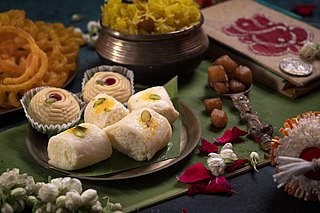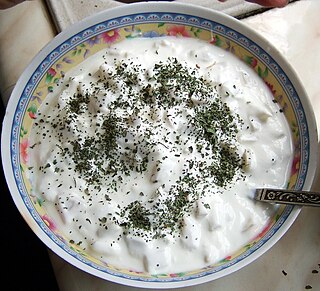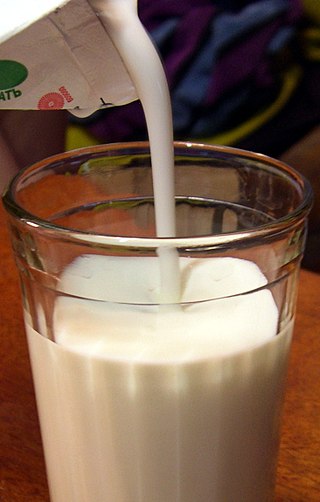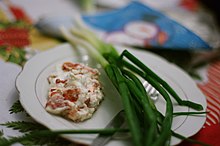
Yogurt is a food produced by bacterial fermentation of milk. The bacteria used to make yogurt are known as yogurt cultures. Fermentation of sugars in the milk by these bacteria produces lactic acid, which acts on milk protein to give yogurt its texture and characteristic tart flavor. Cow's milk is the milk most commonly used to make yogurt. Milk from water buffalo, goats, ewes, mares, camels, and yaks are also used to produce yogurt. The milk used may be homogenized or not. It may be pasteurized or raw. Each type of milk produces substantially different results.

Paneer, also known as ponir, is a fresh acid-set cheese common in the cuisine of the Indian subcontinent made from full-fat buffalo milk or cow milk. It is a non-aged, non-melting soft cheese made by curdling milk with a fruit- or vegetable-derived acid, such as lemon juice.

Crème fraîche is a dairy product, a soured cream containing 10–45% butterfat, with a pH of approximately 4.5. It is soured with a bacterial culture. European labeling regulations specify the two ingredients must be cream and bacterial culture. It is served over fruit and baked goods, as well as being added to soups and sauces. It is used in a variety of other recipes. Sour cream is a similar foodstuff, except that crème fraîche is less sour and has a higher fat content. Sour cream may contain thickening agents not permitted in crème fraîche in many jurisdictions.

Bulgarian cuisine is part of the cuisine of Southeast Europe, sharing characteristics with other Balkan cuisines. Bulgarian cooking traditions are diverse because of geographical factors such as climatic conditions suitable for a variety of vegetables, herbs, and fruit. Aside from the variety of local Bulgarian dishes, Bulgarian cuisine shares a number of dishes with its neighboring countries, in particular with the Turkish and Greek cuisine.

Ayran, doogh, dhallë, dew, avamast, mastaw, shaneena or xynogala is a cold savory yogurt-based beverage popular across Central Asia, West Asia, Southeastern Europe, North Asia and Eastern Europe. The principal ingredients are yogurt, water and salt. Herbs such as mint may be optionally added. Some varieties are carbonated. Ayran is notably quite popular in Iran.

Kashk, qurut, chortan, or aaruul and khuruud is a range of dairy products popular in Middle Eastern cuisine, Caucasian cuisine, and Central Asian cuisine. Kashk is made from strained yogurt, drained buttermilk or drained sour milk by shaping it and letting it dry. It can be made in a variety of forms, like rolled into balls, sliced into strips, and formed into chunks.

Tarhana is a dried food ingredient, based on a fermented mixture of grain and yogurt or fermented milk, found in the cuisines of Central Asia, Southeast Europe and the Middle East. Dry tarhana has a texture of coarse, uneven crumbs, and it is usually made into a thick soup with water, stock, or milk. As it is both acidic and low in moisture, the milk proteins keep for long periods. Tarhana is very similar to some kinds of kashk.

Sandesh is a dessert, originating from the Bengal region in the eastern part of the Indian subcontinent, created with milk and sugar. Some recipes of sandesh call for the use of chhena or paneer instead of milk itself. Some people in the region of Dhaka make a form of sandesh called pranahara which is softer and made with mawa and yogurt. The Gupo/Gufo style of sandesh from Guptipara is considered by some to be the "first branded sweet of Bengal".

Matzoon or matsoni is a fermented milk product of Armenian origin, distributed in Armenia and Georgia. The so-called Caspian Sea yogurt circulated and commercialized in Japan is sometimes said to be the same type of yogurt as matzoon, but a comparison of microbiota and viscosity found that the two are entirely different.

Strained yogurt, Greek yogurt, yogurt cheese, sack yogurt or kerned yogurt is yogurt that has been strained to remove most of its whey, resulting in a thicker consistency than normal unstrained yogurt, while still preserving the distinctive sour taste of yogurt. Like many types, strained yogurt is often made from milk enriched by boiling off some water content, or by adding extra butterfat and powdered milk. In Europe and North America, it is often made from low-fat or fat-free cow's milk. In Iceland, a similar product named skyr is made.

The Oxford Symposium on Food & Cookery is an annual weekend conference at which academics, food writers, cooks, and others with an interest in food and culture meet to discuss current issues in food studies and food history.

Afghan cuisine is influenced to a certain extent by Persian, Central Asian and Indian cuisines due to Afghanistan's close proximity and cultural ties. The cuisine is halal and mainly based on mutton, beef, poultry and fish with rice and Afghan bread. Accompanying these are common vegetables and dairy products, such as milk, yogurt, and whey, and fresh and dried fruits such as apples, apricots, grapes, bananas, oranges, plums, pomegranates, sweet melons, and raisins. The diet of most Afghans revolves around rice-based dishes, while various forms of naan are consumed with most meals. Tea is generally consumed daily in large quantities, and is a major part of hospitality. The culinary specialties reflect the nation's ethnic and geographic diversity. The national dish of Afghanistan is Kabuli palaw, a rice dish cooked with raisins, carrots, nuts, and lamb or beef.

Kefir is a fermented milk drink similar to a thin yogurt or ayran that is made from kefir grains, a specific type of mesophilic symbiotic culture. It is prepared by inoculating the milk of cows, goats, or sheep with kefir grains.
Chalap or shalap or chalob, also marketed as Tan by Enesay, is a beverage common to Kyrgyzstan, Uzbekistan, and Kazakhstan. It consists of qatiq or suzma, salt, and in modern times, carbonated water. The Shoro beverage company markets chalap as "Chalap Shoro".
Qaraqurut is a highly acidic brittle dairy product, made by dehyrating sour whey. It appears eponymously black and is produced in Iran, Afghanistan, Tajikistan and other Central Asian countries. Lighter variants and variants made from other kinds of whey do exist. It is sometimes merely called qārā compare Azeri: قارا, black.

Sour cream is a dairy product obtained by fermenting regular cream with certain kinds of lactic acid bacteria. The bacterial culture, which is introduced either deliberately or naturally, sours and thickens the cream. Its name comes from the production of lactic acid by bacterial fermentation, which is called souring. Crème fraîche is one type of sour cream with a high fat content and less sour taste.

Curd, also mosaru or dahi or Thayir or Perugu, is a traditional yogurt or fermented milk product, originating from and popular throughout the Indian subcontinent. It is usually prepared from cow's milk, and sometimes buffalo milk or goat milk. The word curd is used in Indian English to refer to homemade yogurt, while the term yogurt refers to the pasteurized commercial variety known as heat-treated fermented milk.

















